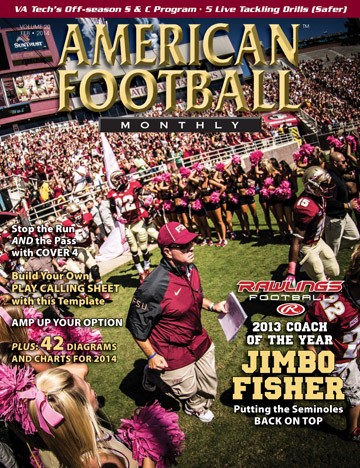Article CategoriesAFM Magazine
|
Managing Your Program: Measuring Practice Success and Developing Good Habitsby: Keith GrabowskiOffensive Coordinator Baldwin-Wallace College © More from this issue With spring football around the corner, coaches are looking to develop or test out some new ideas obtained during the clinic season, identify how personnel will fit into the system and figure out what adjustments will be necessary for the upcoming season. These are legitimate concerns, and spring practice will allow a coaching staff to address them. Spring is also a time to establish the habits that will make the team successful in the fall. Getting the most out of practice by improving the performance of the players on the first team and on the scout team is critical. Effort and execution are the two key components for improvement. In many situations, especially in spring ball, when the upcoming sophomores are learning to adjust to varsity football, the first team is able to have its way with the scout team. Getting a good look from the scout team is always a challenge. Many times coaches become frustrated with the scout team, but in truth, they may be giving all they can give. Putting the focus on the first team players and their effort and execution will pay bigger dividends than being frustrated with the scout team. As long as they can get the proper alignment and assignment that is drawn on the scout card, then the first team players can understand the schemes and concepts that are being executed regardless of the performance of the demonstration players. This doesn’t mean the scout players’ performance is de-emphasized; rather, the focus is shifted off of them. Expectation is maximum effort, but the reality is most scout players are there right now for a reason. They are developing, and it’s just not their time. But they are such a value to the team that their motivation must be kept high by being positive. In some ways, this takes the pressure off of them, and indirectly, measurables are created for them as well. Here are some thoughts on standards and evaluation for spring practice: Make the measurables visible and put a daily emphasis on what the results mean for the performance and progress of the offense. Post the results of each practice in the locker room, giving the number of opportunities for each standard and the number of times it was achieved, resulting in a percentage grade and a comment on what that means overall. For example, “Good practice and tempo, room for improvement,” or “Not a championship effort on the run game because of poor footwork,” or “That was a B-day on pass protection. We can do better.” Put the chart in a place where everyone will see it. Be sure to make comments for the scout team, and consider naming a scout team player of the day. He should be that scout who caused the standards to not be reached the most. For example, a defensive end may have been able to get within the range of the quarterback before the ball was released three times, and may have wrapped up the running back in the first five yards four times. Recognize his effort and other scouts will follow suit. The result will be that the scout team becomes motivated to do more, and overall practice becomes tougher for the first team. Set some initial standards. Maybe some are always a 100% expectation like the ball carrier scoring. Maybe others are more difficult so they are given an 80% standard. However, continually raise the standard as players improve and timing and technique develop. This is a method we implemented at BW this past fall. Overall, this has helped improve our practice effort and execution. Our offensive players have clear standards of what we expect to see on film. This is a method that can be developed for all defense and special teams as well. |
|
| HOME |
MAGAZINE |
SUBSCRIBE | ONLINE COLUMNISTS | COACHING VIDEOS |
Copyright 2024, AmericanFootballMonthly.com
All Rights Reserved




